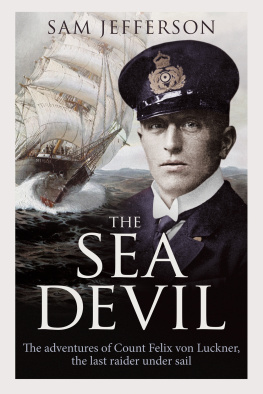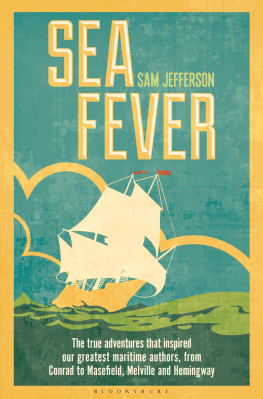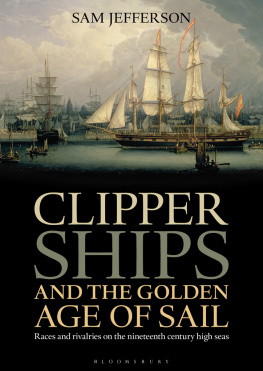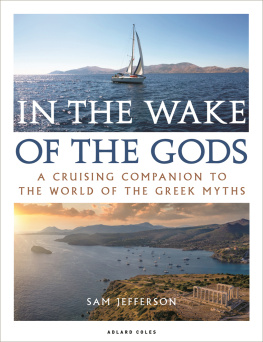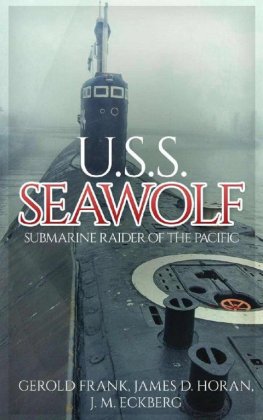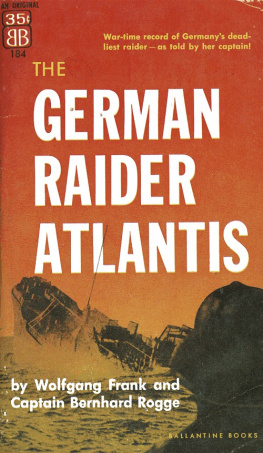Sam Jefferson - The Sea Devil: The Adventures of Count Felix von Luckner, the Last Raider under Sail
Here you can read online Sam Jefferson - The Sea Devil: The Adventures of Count Felix von Luckner, the Last Raider under Sail full text of the book (entire story) in english for free. Download pdf and epub, get meaning, cover and reviews about this ebook. year: 2017, publisher: Osprey Publishing, genre: Non-fiction / History. Description of the work, (preface) as well as reviews are available. Best literature library LitArk.com created for fans of good reading and offers a wide selection of genres:
Romance novel
Science fiction
Adventure
Detective
Science
History
Home and family
Prose
Art
Politics
Computer
Non-fiction
Religion
Business
Children
Humor
Choose a favorite category and find really read worthwhile books. Enjoy immersion in the world of imagination, feel the emotions of the characters or learn something new for yourself, make an fascinating discovery.
- Book:The Sea Devil: The Adventures of Count Felix von Luckner, the Last Raider under Sail
- Author:
- Publisher:Osprey Publishing
- Genre:
- Year:2017
- Rating:3 / 5
- Favourites:Add to favourites
- Your mark:
- 60
- 1
- 2
- 3
- 4
- 5
The Sea Devil: The Adventures of Count Felix von Luckner, the Last Raider under Sail: summary, description and annotation
We offer to read an annotation, description, summary or preface (depends on what the author of the book "The Sea Devil: The Adventures of Count Felix von Luckner, the Last Raider under Sail" wrote himself). If you haven't found the necessary information about the book — write in the comments, we will try to find it.
Sam Jefferson: author's other books
Who wrote The Sea Devil: The Adventures of Count Felix von Luckner, the Last Raider under Sail? Find out the surname, the name of the author of the book and a list of all author's works by series.
The Sea Devil: The Adventures of Count Felix von Luckner, the Last Raider under Sail — read online for free the complete book (whole text) full work
Below is the text of the book, divided by pages. System saving the place of the last page read, allows you to conveniently read the book "The Sea Devil: The Adventures of Count Felix von Luckner, the Last Raider under Sail" online for free, without having to search again every time where you left off. Put a bookmark, and you can go to the page where you finished reading at any time.
Font size:
Interval:
Bookmark:


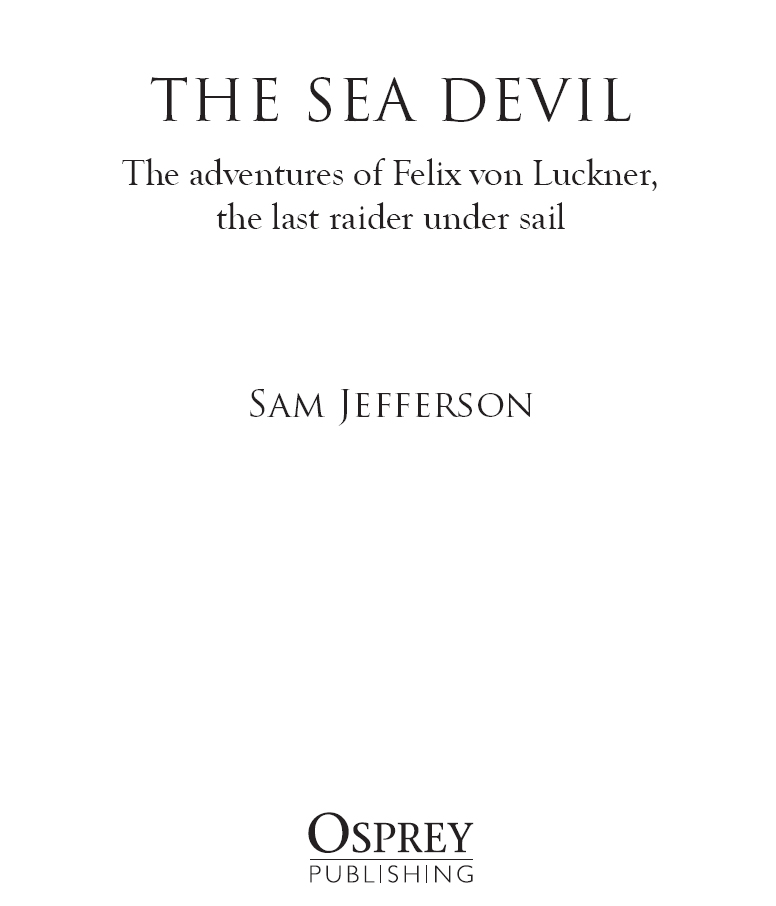
CONTENTS

INTRODUCTION:
POST TRUTH

Forgive me, comrade; how could you be my enemy?
If we threw away these rifles and this uniform you
could be my brother.
ERICH MARIA REMARQUE, ALL QUIET ON THE WESTERN FRONT
In early December 1916, an unassuming windjammer lies at peace in a tranquil anchorage off the island of Sylt in northern Germany. In the crisp winter light, the backdrop of pine-clad shores and sands glows white. The old tall ship swings in a leisurely way with the tide in a state of near perfect equanimity, as if contentedly taking in the scenery. For three weeks she is moored there while the days unfurl and roll by; short winter days a jumble of dark clouds and storms, punctuated by crystalline bursts of beauty and blood red sunsets. All is peaceful aboard and the ship only occasionally twitches and plucks at her anchor chain as if to remind her master that she is ready and willing to get away.
Europe may have been enveloped by the cloud of one of the darkest, bloodiest, cruellest conflicts the world has ever witnessed, but it doesnt seem to have reached this corner of the North Sea. Conflict, urgency, even time itself seem to bypass the sleepy ship as she keeps her lonely vigil in that forgotten backwater. Waiting. Then, at dawn on 17 December, in the face of a freshening breeze, she gets underway.
Suddenly, all is action, and, high up in the rigging, sailors loose the sails to the wind. Far below on the deck, the sails are sheeted home, while the remainder of the crew slowly tramp around the capstan bringing the anchor chain chinking to the surface link by link. As the sails belly to the breeze, the windjammer heels and trembles slightly a tiny shuddering thrill. She is alive once more.
Her decks are loaded high with a cargo of fragrant pine and she looks for all the world like a harmless trading vessel just another elegant, slightly battered remnant of a dying breed. Yet there is more to this old sailing ship than meets the eye. Although she flies the neutral flag of Norway, shes actually part of the German Imperial Navy, and beneath her decks lie 32 machine guns, two four-inch guns, grenades, dynamite and a crew of highly trained German naval officers and sailors. The truth is that she is a raider, and her mission is simple: search and destroy. With the conflict at sea reaching its cruellest and most brutal phase, this raider faces the daunting prospect of trying to break through the British blockade of the North Sea one of the most effective chokeholds any nation has inflicted on another. If she succeeds, she will then be free to carry out her orders: to sink as much Allied shipping as possible. This is SMS Seeadler , the last true warship to operate under sail. The last corsair.
The Seeadler s commander, Felix Graf von Luckner, was a dynamic nobleman possessed of courage to the point of recklessness. He had always been a man with a roving disposition and a habit of getting involved in unlikely adventures. As he gazed out at the German coastline slipping by on that cold December day, he may have already had an inkling that his greatest adventure lay before him just over that horizon. For, as his ship gathered way and the land slowly receded, the Seeadler was on her way to writing her own very strange chapter in the history of World War I: during an epic and often surreal voyage, she succeeded in causing great harm to Allied shipping all achieved with the supposed handicap of being a sailing ship pitched against steamships. This alone was a fine achievement that undoubtedly did much to demoralise the Allied cause. Yet, what could not have been clear to any military strategist was that, when the Seeadler headed out from Sylt that December day, she carried an even more effective weapon than her guns or grenades. She brought something to the war that had been almost totally lacking up to that point: humanity and charisma. It was perhaps these basic commodities that were most damaging to the Allied cause.
The most potent salvo this raider would deliver was upon the Allied propaganda machine. It is often said that in wartime, truth is the first casualty, and, by late 1916, when the Seeadler set out on her unlikely mission, Germany was certainly feeling it: ever since the outbreak of war, on 28 June 1914, it had been bludgeoned by one of the most effective propaganda campaigns the world had ever witnessed.
Facts at times seemed rather pass as the Allies sought to use any means possible to paint the Germans in the worst light possible. Even if smear campaigns were accepted as an inevitable by-product of war, the flagrant disregard for news with any basis in fact was often astonishing. Thus in the early stages of the war, the public was variously informed that German soldiers in Belgium had kept up their spirits by chopping off the hands of babies and that, when this became repetitive, they took to amputating womens breasts for no reason other than their own amusement. In Canada, rumours circulated that soldiers were being crucified by the Germans, while a particularly vile story was that the Germans ran a special corpse factory where the bodies of soldiers were melted down to create soap, glue and other products useful to the war effort.
Needless to say, none of these facts was true, but it didnt matter. As far as the Allies were concerned, the most important thing was to whip up as much anti-German sentiment as possible. War needs to be fuelled by hatred. Fear and loathing are inevitably the focal point of any conflict, and few wars needed a focal point more than World War I. Even with the benefit of hindsight, it is still very hard to establish what the conflict was truly about, never mind who was wrong or right. The result was a fierce propaganda campaign from both sides, as each desperately sought to portray their cause as the just and fair one. By 1916, it was clear there was only one winner on this front, and it was the Allies.
Germany hadnt helped itself: its Zeppelin air raid attacks launched by the German Imperial Navy on British towns and cities were designed to damage British morale, but they also provided prime material for propagandists. On 16 December 1914, German Zeppelins bombed Scarborough, claiming 137 lives, including that of a 14-month-old baby. Winston Churchill, then First Lord of the Admiralty, reacted with delight, stating, Whatever feats of arms the German navy may hereafter perform, the stigma of the baby-killers of Scarborough will brand its officers and men while sailors sail the seas.
He was right. For the remainder of the war, the Germans were frequently labelled baby-killers, while Remember Scarborough became a rallying cry for the British troops. In modern terms, it was PR disaster.
The next huge blunder came at sea. From the beginning of the war, Germany had been cornered by the British blockade, which utilised Britains naval supremacy to cut off all supply lines to Germany from the Atlantic. It was a chokehold that the British never eased for a moment, despite the fact that it was widely recognised as being illegal, contravening treaties that Britain had been instrumental in drawing up regarding the
Writhing within this vice-like grip, the Germans retaliated with unrestricted submarine warfare, which meant that U-boats ignored prize rules (which dictated that U-boats and Allied submarines surface and give vessels time to evacuate before they were torpedoed) and instead sank any Allied vessel without prior warning. This method of menacing shipping reached its nadir on 7 May 1915, when RMS Lusitania , one of the largest, fastest and most prestigious transatlantic liners in the world, was sunk without warning by a U-boat, U-20, as she approached Ireland. She sank in 18 minutes, claiming 1,198 lives.
Font size:
Interval:
Bookmark:
Similar books «The Sea Devil: The Adventures of Count Felix von Luckner, the Last Raider under Sail»
Look at similar books to The Sea Devil: The Adventures of Count Felix von Luckner, the Last Raider under Sail. We have selected literature similar in name and meaning in the hope of providing readers with more options to find new, interesting, not yet read works.
Discussion, reviews of the book The Sea Devil: The Adventures of Count Felix von Luckner, the Last Raider under Sail and just readers' own opinions. Leave your comments, write what you think about the work, its meaning or the main characters. Specify what exactly you liked and what you didn't like, and why you think so.

